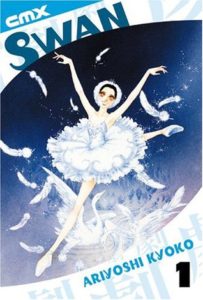Manga Review: Swan Vol. 1 by Kyoko Ariyoshi
Masumi Hijiri is the daughter of a widowed sculptor, who has enjoyed her ballet lessons since she was a little girl. She loves to dance, and watch others perform in ballet. But stuck in a small city in rural Hokkaido, there just isn’t the chance for truly expert training. So when Masumi suddenly gets an invitation to compete in a national ballet scouting event, with instruction at the top Otori School as a prize, she decides to give it her all!
This famous shoujo (girls’) manga started in 1976 and ran for 21 volumes, of which 15 were published in English by the ill-fated CMX label. There was a surge of interest in ballet dancing in Japan at the time, and the creator did a lot of research to make the movements and poses look right.
The handicap of Masumi’s inferior training is offset by her enormous potential as a prima ballerina, or so we are led to believe by every experienced instructor’s reactions to her dancing. She’s still very much prone to moments of comical klutziness. Masumi is chosen to attend Otori, and it’s at this point she learns her mother was in fact a locally famous ballerina herself. Somehow this has never come up in conversation with her father or teachers before. (But it will be a recurring plot point later in the series.)
At school, Masumi becomes good friends with Sayoko Kyogoku (who is also her rival), the handsome Hisho Kusakabe who is Sayoko’s long-time partner, and Aoi Yanagisawa, who is Hisho’s friendly rival. They all train rigorously. Masumi is soon struggling to keep up, and is signed up for extra training with famous Russian dancer Alexei Sergeiev, along with the impulsive Yuka Asagi.
It turns out that all this was preparation for a contest to see which Otori students get to go to Moscow to train with that internationally acclaimed ballet troupe. The ballet is “Sleeping Beauty” and Sayoko, Masumi and Yuka are all dancing for the role of Aurora–only one of them will succeed!
This manga is made in the flowery, elaborately detailed style popular in shoujo in the 1970s, which works very well for the world of ballet. It’s also expressive of the melodramatic emotions the characters undergo. Modern readers may find the art style somewhat antiquated and over the top.
While the creator did her research, there are some moments that are not particularly realistic in order to ratchet up the dramatic tension–those well-trained in the ballet field will easily spot them.
I am uncertain if it is the paper quality or I simply got unlucky with storage, but my copy’s pages have discolored much more than other manga volumes printed at the same time. Collectors may have a hard time finding a copy in mint condition.
Recommended to fans of ballet or the Princess Tutu anime, especially girls.

